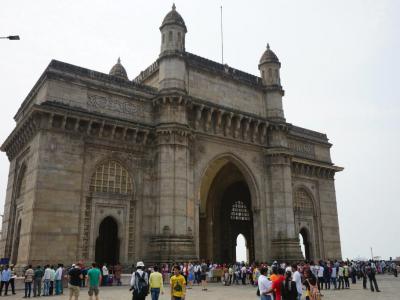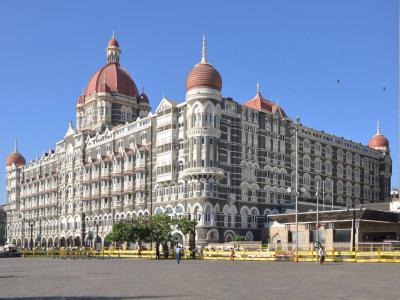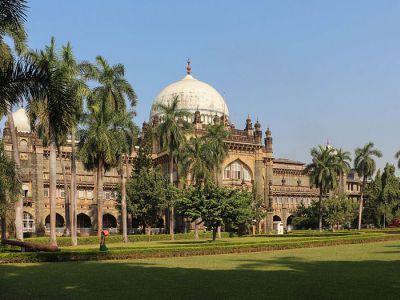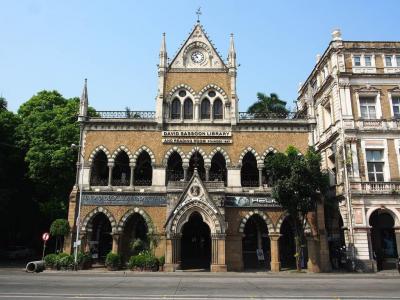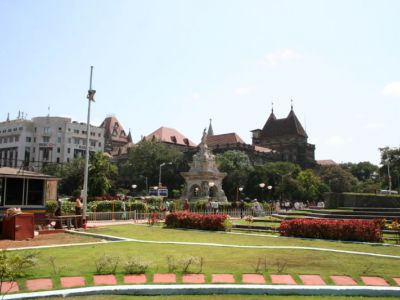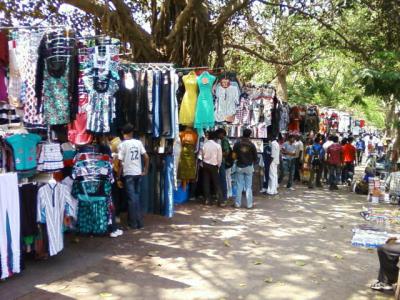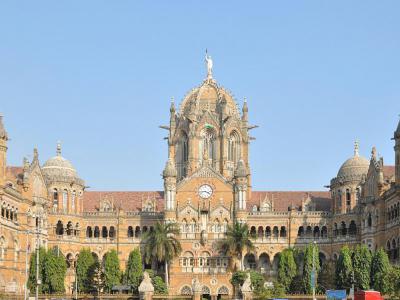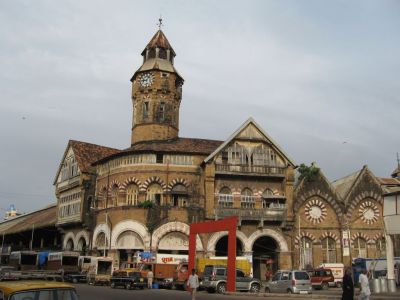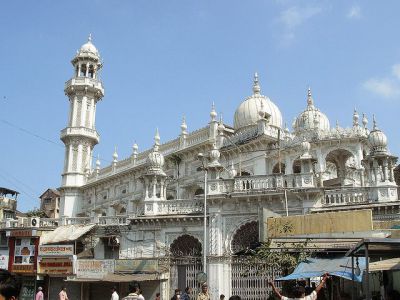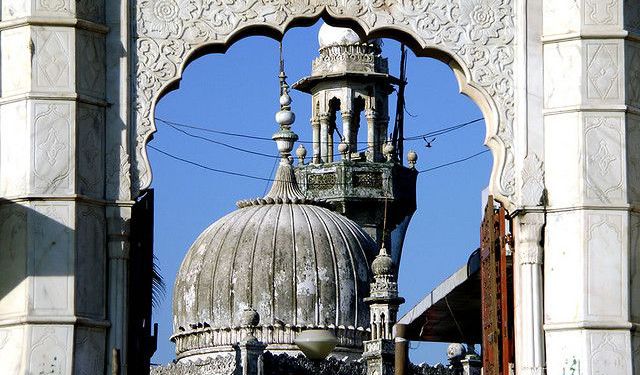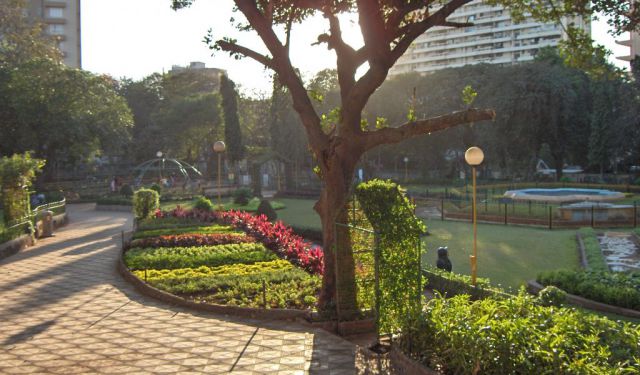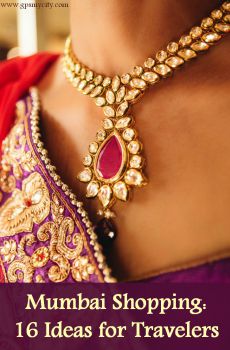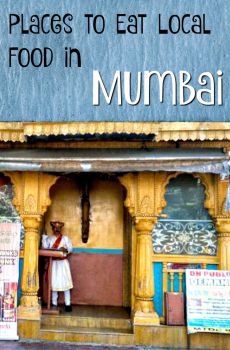Mumbai Introduction Walking Tour (Self Guided), Mumbai
Mumbai (previously known as Bombay, meaning "good bay") is a thriving metropolis on the shore of the Mumbai Harbor. The city is the financial, commercial, and entertainment capital of India, and a home to three UNESCO World Heritage Sites and Bollywood.
Portuguese took control of Mumbai in 1534. In 1661 they gifted it to the British, as part of the dowry from Catherine of Braganza, daughter of King John IV of Portugal, upon her marriage to Charles II of England.
Mumbai saw a major construction boom in the 18th century when William Hornby, the city governor, kicked off an ambitious project linking all the seven Mumbai's islands into a single land mass. The initiative thus marked the outset of the area's industrial revolution.
Today, visitors to Mumbai can witness a number of iconic pieces of architecture. Chief among them is the Gateway of India stone arch, one of the country's major landmarks, built in 1911 to celebrate the first ever visit to the country by a British Monarch. The nearby Taj Mahal Hotel, with its seamless blend of the Indo-Saracenic Revival architectural style, is without a doubt one of the most beautiful hotels in Asia.
Victoria Terminus, another perfect marriage of Indian and western architectural styles, has been an icon of Mumbai since 1887. A UNESCO World Heritage Site, it is a definite must-see for anyone visiting the city.
To find out more about Mumbai's top attractions at your own pace, follow this self-guided walking tour.
Portuguese took control of Mumbai in 1534. In 1661 they gifted it to the British, as part of the dowry from Catherine of Braganza, daughter of King John IV of Portugal, upon her marriage to Charles II of England.
Mumbai saw a major construction boom in the 18th century when William Hornby, the city governor, kicked off an ambitious project linking all the seven Mumbai's islands into a single land mass. The initiative thus marked the outset of the area's industrial revolution.
Today, visitors to Mumbai can witness a number of iconic pieces of architecture. Chief among them is the Gateway of India stone arch, one of the country's major landmarks, built in 1911 to celebrate the first ever visit to the country by a British Monarch. The nearby Taj Mahal Hotel, with its seamless blend of the Indo-Saracenic Revival architectural style, is without a doubt one of the most beautiful hotels in Asia.
Victoria Terminus, another perfect marriage of Indian and western architectural styles, has been an icon of Mumbai since 1887. A UNESCO World Heritage Site, it is a definite must-see for anyone visiting the city.
To find out more about Mumbai's top attractions at your own pace, follow this self-guided walking tour.
How it works: Download the app "GPSmyCity: Walks in 1K+ Cities" from Apple App Store or Google Play Store to your mobile phone or tablet. The app turns your mobile device into a personal tour guide and its built-in GPS navigation functions guide you from one tour stop to next. The app works offline, so no data plan is needed when traveling abroad.
Mumbai Introduction Walking Tour Map
Guide Name: Mumbai Introduction Walking Tour
Guide Location: India » Mumbai (See other walking tours in Mumbai)
Guide Type: Self-guided Walking Tour (Sightseeing)
# of Attractions: 9
Tour Duration: 2 Hour(s)
Travel Distance: 3.9 Km or 2.4 Miles
Author: emma
Sight(s) Featured in This Guide:
Guide Location: India » Mumbai (See other walking tours in Mumbai)
Guide Type: Self-guided Walking Tour (Sightseeing)
# of Attractions: 9
Tour Duration: 2 Hour(s)
Travel Distance: 3.9 Km or 2.4 Miles
Author: emma
Sight(s) Featured in This Guide:
- Gateway of India
- Taj Mahal Hotel
- Chhatrapati Shivaji Maharaj Vastu Sangrahalaya
- David Sassoon Library
- Hutatma Chowk
- Fashion Street
- Victoria Terminus
- Crawford Market
- Jumma Masjid
1) Gateway of India (must see)
Built on reclaimed land of the Apollo Bundar, the Gateway of India was constructed to commemorate the visit of King George V and Queen Mary to India in 1911, the first ever by a British Monarch. Later, it became a landing port for British governors and distinguished guests and also the port of exit for the British Empire when the country gained its independence.
Designed by Scotsman George Wittet, the Gateway of India is a perfect example of an Indo-Saracenic style of architecture. With a signature central dome and largely Hindu designs and inscriptions, the monument is simply a gateway to the Indian society and showcases its unity in spite of its cultural diversity. Although the foundations for the building were laid in 1913, work did not start until 1920 due to the time taken for reclamation of the land. Built from yellow basalt sourced from local quarries, the structure was formally inaugurated in 1924.
Boats ferry from this point to the Elephanta Caves or one can just take a luxury boat around the harbor for a couple of hours. The famous Taj Mahal Hotel, which is twenty years older than the Gateway of India stands exactly opposite this monument and is also known for its splendid architecture.
Designed by Scotsman George Wittet, the Gateway of India is a perfect example of an Indo-Saracenic style of architecture. With a signature central dome and largely Hindu designs and inscriptions, the monument is simply a gateway to the Indian society and showcases its unity in spite of its cultural diversity. Although the foundations for the building were laid in 1913, work did not start until 1920 due to the time taken for reclamation of the land. Built from yellow basalt sourced from local quarries, the structure was formally inaugurated in 1924.
Boats ferry from this point to the Elephanta Caves or one can just take a luxury boat around the harbor for a couple of hours. The famous Taj Mahal Hotel, which is twenty years older than the Gateway of India stands exactly opposite this monument and is also known for its splendid architecture.
2) Taj Mahal Hotel
The Taj Mahal Palace Hotel is a luxury hotel located on the Colaba peninsula in Mumbai. The hotel is one of the most recognized city landmarks. The Taj, as it is often called, was named after the Taj Mahal in Agra.
The Taj was built in 1903 by conglomerate corporation Tata. The architect, Sitaram Khanderao Vaidya D.N. Mirza, designed the Taj in the Indo-Saracenic Revival architectural style.
One of the most iconic features of the Taj is its central floating staircase. It is also noted for being the first hotel in India to have electricity and elevators.
The Taj has hosted famous clientele from around the world. Figures like Lord Mountbatten and Bill Clinton have stayed at the hotel. A number of movies have been shot in and around the hotel. Most recently, Christopher Nolan's "Tenet" was filmed at the Taj.
Visitors who do not book a room at the Taj Mahal Palace Hotel can still glimpse the interior by visiting one of the hotel bars, the hotel restaurant or shopping mall. A heritage tour of the hotel is also available.
Many tourists choose to enjoy the view of the Taj from the Gateway of India, which is located nearby.
The Taj was built in 1903 by conglomerate corporation Tata. The architect, Sitaram Khanderao Vaidya D.N. Mirza, designed the Taj in the Indo-Saracenic Revival architectural style.
One of the most iconic features of the Taj is its central floating staircase. It is also noted for being the first hotel in India to have electricity and elevators.
The Taj has hosted famous clientele from around the world. Figures like Lord Mountbatten and Bill Clinton have stayed at the hotel. A number of movies have been shot in and around the hotel. Most recently, Christopher Nolan's "Tenet" was filmed at the Taj.
Visitors who do not book a room at the Taj Mahal Palace Hotel can still glimpse the interior by visiting one of the hotel bars, the hotel restaurant or shopping mall. A heritage tour of the hotel is also available.
Many tourists choose to enjoy the view of the Taj from the Gateway of India, which is located nearby.
3) Chhatrapati Shivaji Maharaj Vastu Sangrahalaya
If you love visiting museums and artefacts from the city’s past, then the Chhatrapati Shivaji Maharaj Vastu Sangrahalaya in Mumbai is a must visit. Set in the backdrop of the very busy and urban South Mumbai, the Museum manages to take its visitors away from the hustle bustle around. In the midst of a breathtaking garden, the Indo-Saracenic styled building looks enchanting.
Built in the early 20th century, the Chhatrapati Shivaji Maharaj Vastu Sangrahalaya was constructed in honour of King George V, who was then, the Prince of Wales. The foundation stone was laid by Prince of Wales on the 11th of November 1905. The building took 9 years to complete after which it was used by the military as a hospital. It was not until 1922 that the premises were finally declared a museum and opened to the public.
The Museum is one of the finest in the country and boasts a vast collection of artefacts right from the Indus valley civilization to relics from flourishing empires like the Rastrakuttas, Guptas, Mauryas, Chalukas and of course the Mughal era.
Built in the early 20th century, the Chhatrapati Shivaji Maharaj Vastu Sangrahalaya was constructed in honour of King George V, who was then, the Prince of Wales. The foundation stone was laid by Prince of Wales on the 11th of November 1905. The building took 9 years to complete after which it was used by the military as a hospital. It was not until 1922 that the premises were finally declared a museum and opened to the public.
The Museum is one of the finest in the country and boasts a vast collection of artefacts right from the Indus valley civilization to relics from flourishing empires like the Rastrakuttas, Guptas, Mauryas, Chalukas and of course the Mughal era.
4) David Sassoon Library
Mumbai is a large metropolis with a history that goes back several centuries. A long walk in South Mumbai will introduce you to the city’s brilliant combination of people, heritage and history. Although the city is crammed with urban styled buildings, residential complexes and skyscrapers, it still has its fair share of monumental buildings, heritage spots and architectural wonders. One such place you will come across while exploring the city is the David Sassoon Library.
Built in 1870, it is one of the many sites in the city protected and deemed as a heritage spot. The Library is a fantastic Venetian Gothic style building, with a unique rustic appeal that takes you back to the era of black and white. In the midst of the hustle and bustle of the city, the Library stands out with its simplicity and modest look. The building was constructed after receiving assistance from a rich banker by the name Sir David Sassoon. His contribution of a sum of Rs. 60,000, gave the Library its name. However, the initial idea for the Library was the brainchild of a group of young mechanics and foremen, who wanted to establish an education centre displaying various mechanical models. Today, along with the Library that houses a collection of rare books, the building also boasts a museum which is worth visiting.
Built in 1870, it is one of the many sites in the city protected and deemed as a heritage spot. The Library is a fantastic Venetian Gothic style building, with a unique rustic appeal that takes you back to the era of black and white. In the midst of the hustle and bustle of the city, the Library stands out with its simplicity and modest look. The building was constructed after receiving assistance from a rich banker by the name Sir David Sassoon. His contribution of a sum of Rs. 60,000, gave the Library its name. However, the initial idea for the Library was the brainchild of a group of young mechanics and foremen, who wanted to establish an education centre displaying various mechanical models. Today, along with the Library that houses a collection of rare books, the building also boasts a museum which is worth visiting.
5) Hutatma Chowk
If you love to explore Mumbai's diverse culture and heritage, one such area worth visiting on foot is the Hutatma Chowk.
Known for its bloody past, the Hutatma Chowk was the breeding ground for the idea of an independent state of Maharashtra. Commemorating this event is a statue of a martyr with a torch, which reminds the people of the bloody struggle in 1960 between the members of the Samyukta Maharashtra Samiti and the Government of India, which led to the independent state of Maharashtra.
The Chowk is also known for another monument, the Flora Fountain. Ornate, immaculate and timeless, the Flora fountain has overlooked this neighborhood for over two centuries. Built in 1864, the Fountain was built in honor of the then Governor of Bombay, Sir Bartle Frere. Carved in stone, the fountain was designed by Norman Shaw and created by James Forsythe. Representing Flora, the goddess of abundance, the fountain was constructed by the Agri-Horticultural Society of Western India.
Apart from the statue and the fountain, the entire area is filled with buildings and structures constructed during the Britain’s colonization of the country. A must visit when in Mumbai.
Known for its bloody past, the Hutatma Chowk was the breeding ground for the idea of an independent state of Maharashtra. Commemorating this event is a statue of a martyr with a torch, which reminds the people of the bloody struggle in 1960 between the members of the Samyukta Maharashtra Samiti and the Government of India, which led to the independent state of Maharashtra.
The Chowk is also known for another monument, the Flora Fountain. Ornate, immaculate and timeless, the Flora fountain has overlooked this neighborhood for over two centuries. Built in 1864, the Fountain was built in honor of the then Governor of Bombay, Sir Bartle Frere. Carved in stone, the fountain was designed by Norman Shaw and created by James Forsythe. Representing Flora, the goddess of abundance, the fountain was constructed by the Agri-Horticultural Society of Western India.
Apart from the statue and the fountain, the entire area is filled with buildings and structures constructed during the Britain’s colonization of the country. A must visit when in Mumbai.
6) Fashion Street
Shopping in Mumbai is at its peak on Fashion Street. Visitors can shop at one of the hundreds of booths that sell clothing, textiles, jewelry and accessories.
The street is famous for bargain-basement deals on all items. Even name-brand clothing is plentiful. One thing shoppers won't find are price tags. With few exceptions, prices are quoted with the expectation of bargaining.
Tourists will also find plenty of food on Fashion Street. They can stop by a street vendor for snacks or pop into a restaurant for a delicious meal of local cuisine.
Fashion is located on Mahatma Gandhi between Cross Maidan and Azad Maidan. It is a quick walk to a number of popular tourist sites like Flora Fountain and Saint Thomas' Cathedral.
The vendors on Fashion Street open their booths daily at 11 AM. They remain open until 8 PM. Those who visit on weekends will share the space with a large number of locals and tourists alike. Good deals can be found no matter when you visit.
The street is famous for bargain-basement deals on all items. Even name-brand clothing is plentiful. One thing shoppers won't find are price tags. With few exceptions, prices are quoted with the expectation of bargaining.
Tourists will also find plenty of food on Fashion Street. They can stop by a street vendor for snacks or pop into a restaurant for a delicious meal of local cuisine.
Fashion is located on Mahatma Gandhi between Cross Maidan and Azad Maidan. It is a quick walk to a number of popular tourist sites like Flora Fountain and Saint Thomas' Cathedral.
The vendors on Fashion Street open their booths daily at 11 AM. They remain open until 8 PM. Those who visit on weekends will share the space with a large number of locals and tourists alike. Good deals can be found no matter when you visit.
7) Victoria Terminus (must see)
The Chhatrapati Shivaji Terminus in Mumbai was declared a UNESCO Wolrd Heritage Site in 2004 and is truly an icon of the city. Located in the Bori Bunder area it is the busiest railway station in India. Its edifice designed by the British architect Frederick William Stevens, was built over a span of 10 years starting in 1878 and was inaugurated on the silver jubilee of Empress Victoria in 1887.
Formerly known as Victoria Terminus, the building was intended to house administrative offices of the Great Indian Peninsula Railway but serves as the headquarters of the Central Railways now. In order to honor the great Maratha warrior, Shivaji, the terminus was renamed as Chhatrapati Shivaji Terminus by the Ministry of Railways in 1996. The terminus is used by over 3 million commuters everyday.
The terminus is a perfect blend of Indian and Victorian Italianate Gothic Revival architecture. Pointed arches, turrets anchoring the 4 corner wings, railings of ornamental iron and brass, balustrades for the grand staircases, Neo-Gothic roof in the hall and a central dome with dovetailed ribs are some of the architectural highlights of this historical building.
An interesting symbol of Britain and India in the form of a stone sculpture of a lion and a tiger is seen atop the entrance gate. A symbol of progress is seen in the form of a 4-meter high statue of a female figure holding a spoked wheel in her left hand and a torch in her right, on top of the octagonal ribbed central dome having animal shaped water sprouts.
Formerly known as Victoria Terminus, the building was intended to house administrative offices of the Great Indian Peninsula Railway but serves as the headquarters of the Central Railways now. In order to honor the great Maratha warrior, Shivaji, the terminus was renamed as Chhatrapati Shivaji Terminus by the Ministry of Railways in 1996. The terminus is used by over 3 million commuters everyday.
The terminus is a perfect blend of Indian and Victorian Italianate Gothic Revival architecture. Pointed arches, turrets anchoring the 4 corner wings, railings of ornamental iron and brass, balustrades for the grand staircases, Neo-Gothic roof in the hall and a central dome with dovetailed ribs are some of the architectural highlights of this historical building.
An interesting symbol of Britain and India in the form of a stone sculpture of a lion and a tiger is seen atop the entrance gate. A symbol of progress is seen in the form of a 4-meter high statue of a female figure holding a spoked wheel in her left hand and a torch in her right, on top of the octagonal ribbed central dome having animal shaped water sprouts.
8) Crawford Market
No visit to any city is complete without touring its busiest and oldest markets, and if you are in a mood for adventure, there is no place like Crawford Market. Located in South Mumbai, Crawford Market is one place, bustling with life and infused with its own blend of sights, sounds and scents.
Spread across an area of 22,471 square meters, the market is filled with fruit and vegetable vendors along with upscale shops that sell imported goods as well as exotic pets. It is here that one can truly appreciate the essence of the city and the regular routine of its denizens.
Built in 1869, the main market was designed by Lockwood Kipling, father of the renowned novelist Rudyard Kipling. Boasting a Norman, Flemish architectural style, the building is a brilliant addition of western architecture to the Mumbai skyline. An interesting fact about the Crawford Market is that it was the first building in India to be lit up by electricity.
Named after the first Municipal commissioner of Bombay - Arthur Crawford, the building was donated to the state by Sir Cowasji Jehangir, 2nd Baronet, a wealthy Indian industrialist. Be well prepared, for this place is a market in every sense of the word.
Spread across an area of 22,471 square meters, the market is filled with fruit and vegetable vendors along with upscale shops that sell imported goods as well as exotic pets. It is here that one can truly appreciate the essence of the city and the regular routine of its denizens.
Built in 1869, the main market was designed by Lockwood Kipling, father of the renowned novelist Rudyard Kipling. Boasting a Norman, Flemish architectural style, the building is a brilliant addition of western architecture to the Mumbai skyline. An interesting fact about the Crawford Market is that it was the first building in India to be lit up by electricity.
Named after the first Municipal commissioner of Bombay - Arthur Crawford, the building was donated to the state by Sir Cowasji Jehangir, 2nd Baronet, a wealthy Indian industrialist. Be well prepared, for this place is a market in every sense of the word.
9) Jumma Masjid (must see)
The perfect way to explore any city is on foot and Mumbai is no exception. South Mumbai, especially, is scattered with historical monuments and museums that help better understand the origins and the complex history and culture of the city. But for several reasons, only a selected few of them have achieved the status and are treated like historical monuments. The rest have managed to get absorbed into the background, have lost their identity and as a result have blended in with their surroundings.
One such place is the Jumma Masjid. This antique monument has been around since the 18th century. It is said that the Masjid was initially located near the Crawford Market but was destroyed and constructed at Esplanade only to be destroyed once again upon orders from Governor William Hornby, who did not want any building within 600 yards of the Fort area. The venue of the Masjid was then shifted to its present location and construction started in 1775. It took nearly 25 years before the mosque was completed.
Also known as the Friday Masjid, the mosque is under the administration of the Kokni Muslim community of Mumbai. A definite visit when you are in the city of Mumbai.
One such place is the Jumma Masjid. This antique monument has been around since the 18th century. It is said that the Masjid was initially located near the Crawford Market but was destroyed and constructed at Esplanade only to be destroyed once again upon orders from Governor William Hornby, who did not want any building within 600 yards of the Fort area. The venue of the Masjid was then shifted to its present location and construction started in 1775. It took nearly 25 years before the mosque was completed.
Also known as the Friday Masjid, the mosque is under the administration of the Kokni Muslim community of Mumbai. A definite visit when you are in the city of Mumbai.
Walking Tours in Mumbai, India
Create Your Own Walk in Mumbai
Creating your own self-guided walk in Mumbai is easy and fun. Choose the city attractions that you want to see and a walk route map will be created just for you. You can even set your hotel as the start point of the walk.
Mumbai's Historical Churches
The seven islands making up Mumbai were originally home to the communities of the Marathi language-speaking Koli people whose main religion is Hindu. Under the Mughal Imperial rule, Mumbai adopted Islam, so today roughly 20% of the local population are Muslims.
When the Portuguese took over the city in 1534, they actively enforced the Roman Catholic order, later followed by the British who... view more
Tour Duration: 2 Hour(s)
Travel Distance: 3.8 Km or 2.4 Miles
When the Portuguese took over the city in 1534, they actively enforced the Roman Catholic order, later followed by the British who... view more
Tour Duration: 2 Hour(s)
Travel Distance: 3.8 Km or 2.4 Miles
Malabar Hill Walking Tour
Malabar Hill, Mumbai's swanky residential area, is home to numerous movie stars and business tycoons, with the price of property enough to make even Manhattan blush. Besides luxury mansions, though, this upscale neighborhood is also known for its historical and cultural significance as well as picturesque views. It's a place where you can explore various landmarks that offer a glimpse... view more
Tour Duration: 2 Hour(s)
Travel Distance: 3.4 Km or 2.1 Miles
Tour Duration: 2 Hour(s)
Travel Distance: 3.4 Km or 2.1 Miles
Useful Travel Guides for Planning Your Trip
Mumbai Shopping: 16 Souvenir Ideas for Travelers
In India, a foreigner can't get far without insider knowledge, whether it's for souvenir shopping or something else. Mumbai (formerly known as Bombay) is by far the most popular and the largest of Indian cities, teeming with a plethora of things representative of India's millenia-long...
Places to Eat Local Food in Mumbai
As its said, in a city like Mumbai, anybody wanting a good meal any time of the day, there’s always a rush and a stomach will always be fed. Whether its a quick bite or to indulge yourself, there is a plethora of tastes and flavours, 24/7, vying to satiate your taste buds. Multifaceted,...
The Most Popular Cities
/ view all



